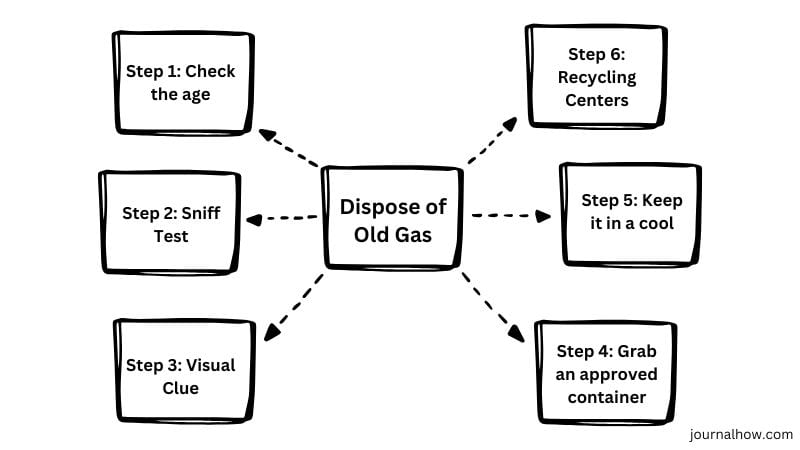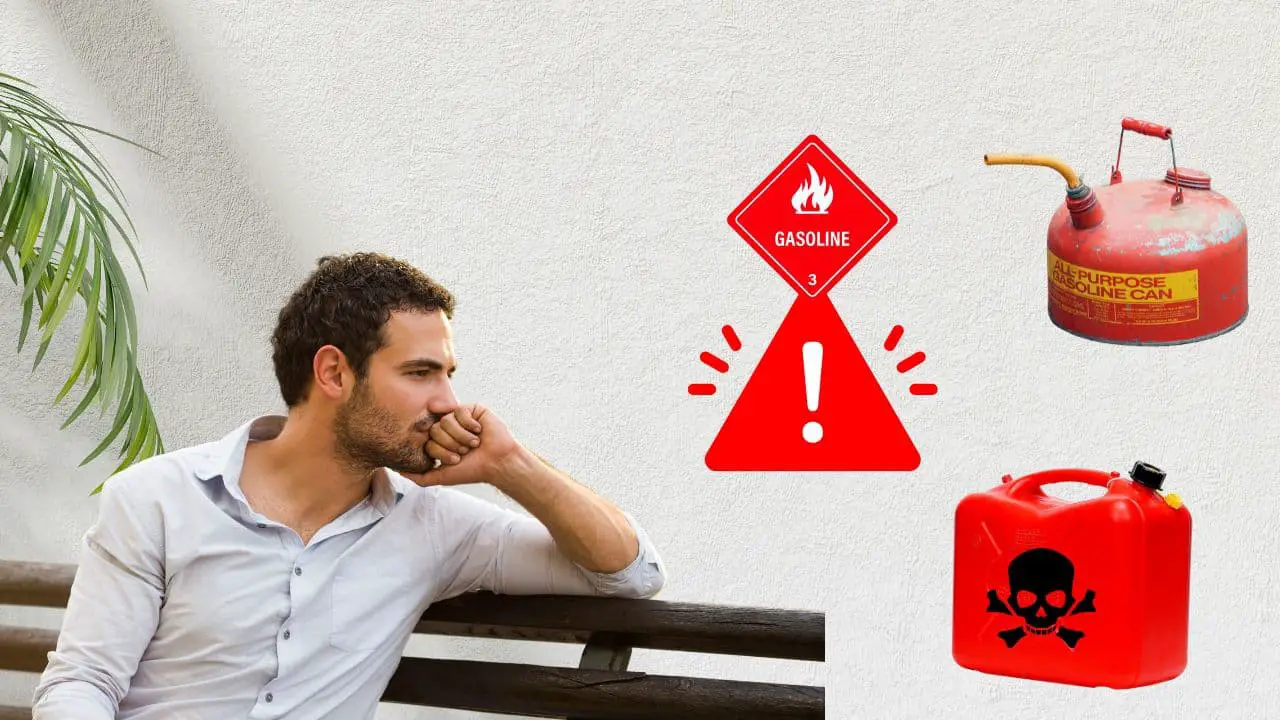Ever found yourself staring at a rusty can of old gas, wondering, “What do I do with this stuff?” Whether it’s leftover fuel from your lawnmower, an old car, or that mystery container in the garage, figuring out a technique to dispose of an old gas can feel overwhelming. But don’t worry—I’ve got your back!
I’ll walk you through the safest, most responsible ways to get rid of old gasoline, sprinkle in some personal experience (spoiler: I almost messed up big time!), and share key safety tips with a dash of science to explain why it all matters. Let’s solve this gas-tastrophe together! 🚗💨
How to Dispose of Old Gas? (Step By Step Guide)
Old gas isn’t only a hassle—it’s a potential hazard. Gasoline is highly flammable, and its vapors can ignite faster than you can say “oops.” Pouring it down the drain or tossing it in the trash? Big no-no! 🚫 Not only could you spark a fire, but you’d also risk contaminating the environment—think soil, water, and wildlife. I used to think it wasn’t a big deal, but trust me, it is. So, let’s talk about how to safely dispose of old gasoline and why it’s worth doing right.
Let’s also talk about something we’ve all faced: that crusty gas can sitting in your garage since the Bush administration. You know, the one you’ve been side-eyeing every time you mow the lawn? Yeah, that one. Disposing of old gas isn’t exactly a thrill ride, but doing it wrong can turn your backyard into an EPA horror story. Let’s tackle this together—safely, easily, and with some FAQ.

Step 1: Is Your Gas Really “Old” or Just Having a Midlife Crisis?
Before you panic, check if your gas is actually expired:
Check the age: Gas less than 6 months old might still be good if it hasn’t been contaminated (e.g., no water or dirt mixed in).
- Sniff Test: Fresh gas smells sharp and pungent. Old gas? Think “varnish” or “sour milk.” 🤢
- Visual Clue: Good gas is clear or amber. Bad gas looks cloudy or has layers (like a sad cocktail).
- The Match Test: JUST KIDDING. 🔥 Do not light a match. Ever.
Personal Blunder Alert: I once tried using year-old gas in my lawnmower. It coughed, sputtered, and died like a drama queen. Lesson learned: When in doubt, toss it out.
Pro tip: If it’s usable, mix it with fresh gas (like a 1:3 ratio) and burn it off in your vehicle or equipment. 🚜 Saves you a trip!
Step 2: How to Dispose of Old Gas (Without Becoming a Meme)
Grab an approved container: Transfer usable gas into a clean, airtight gas can labeled for gasoline. No random water jugs, please!
Stash it safely: Keep it in a cool, ventilated spot away from heat, sunlight, or anything sparky. 🔥 Think garage shelf, not next to the BBQ.
Option 1: Recycling Centers (The MVP of Disposal)
Most cities have hazardous waste facilities that take old gas for free. Google “[Your City] + hazardous waste disposal” or check Earth911’s tool. Pro tip: Call ahead—some spots require appointments.
Option 2: Auto Shops or Fire Departments
Some mechanics or fire stations accept old gas, especially if you bat your eyelashes and ask nicely.
Option 3: Mix It with Fresh Gas (For the Bold)
If your gas is only slightly old (think 2-3 months), dilute it with fresh gas at a 1:4 ratio and use it in your lawn equipment. Warning: This is like feeding your mower leftovers—it might work, but don’t blame me if it gets indigestion.
Step 3: Store It Right (If It’s Good)
- Grab an approved container: Transfer usable gas into a clean, airtight gas can labeled for gasoline. No random water jugs, please!
- Stash it safely: Keep it in a cool, ventilated spot away from heat, sunlight, or anything sparky. 🔥 Think garage shelf, not next to the BBQ.
Step 4: Find a Hazardous Waste Facility (If It’s Bad)
- Why not dump it? Pouring gas down the drain or into the ground risks fires, explosions, and environmental damage. Not cool. 🌿
- Where to go: Look up a local hazardous waste disposal site. Most cities have drop-off points or collection days.
- How to find one: Search “hazardous waste disposal near me” or call your local government. Some auto shops might take small amounts too—just ring them first. 📞
Step 5: Transport It Like a Pro
- Secure the container: Use a sealed, approved gas can—no leaks allowed!
- Load it up: Place it upright in your trunk or truck bed, crack a window for airflow, and make sure it won’t tip.
- Drive smart: Take it easy on the turns. You’re not in a Fast & Furious chase scene here!
Step 6: Drop It Off
- Follow the rules: Every facility’s a little different, so listen to the staff.
- Ask away: Not sure about something? Speak up! They’re there to help you nail safe disposal of old gas.
Safety Tips: Don’t Be That Guy on YouTube ☠️
- Wear Gloves and Goggles: Gasoline is a skin irritant. No one wants chemical burns for the ‘gram.
- Ventilate, Ventilate, Ventilate: Work outside or in a well-ventilated area. Inhaling fumes = bad life choice.
- Use a Government-Approved Container: That old milk jug? Nope. Use a DOT-approved gas can (think: sturdy, leak-proof).
- No Sparks, No Smoking, No Nonsense: Gas vapors are flammable. Keep away from heaters, lighters, and your pyro cousin Larry.
The Science Bit: Gasoline’s volatile—it evaporates fast, and its vapors are heavier than air. They can pool in low spots and ignite with just a tiny spark. That’s why safety precautions for handling old gas are non-negotiable!
How to Avoid This Mess Next Time (Because Adulting is Hard)
- Use Fuel Stabilizer: Add stabilizer (like STA-BIL) to fresh gas if you’re storing it longer than 30 days. It’s like vitamins for your gasoline!
- Store Smart: Keep gas in a cool, dry place. Your attic or trunk? Terrible ideas.
- Buy Less Gas: Only stockpile what you’ll use in 3 months. Your garage isn’t a Costco.
Why You Can’t Just Dump Old Gas in Your Neighbor’s Rosebushes
First off, gasoline is like that toxic ex you can’t shake—it’s bad news for the environment. One gallon of gas can contaminate 750,000 gallons of water (thanks, EPA!). Plus, pouring it down the drain or tossing it in the trash is illegal in most places. Let’s not end up on the wrong side of Mother Nature or the law, okay?
Fun Fact: Gasoline starts degrading in 3-6 months. Ethanol-blended gas (the stuff most of us use) absorbs moisture, leading to “phase separation.” Translation: It turns into a useless, engine-clogging sludge. Science says so—SAE International backs this up!
The Environmental Impact: Why This Matters More Than You Think
Still tempted to pour that gas out? Let’s talk about why that’s a terrible idea:
- Water woes: The EPA says 1 gallon of gasoline can contaminate up to 750,000 gallons of water. 💧 That’s a swimming pool’s worth of poison!
- Soil and wildlife harm: It kills plants, messes with animals, and wrecks the tiny critters that keep ecosystems humming. 🌱
- Fines alert: Dumping gas illegally can hit you with penalties. Save the planet and your bank account! 💸
Proper disposal isn’t only about rules—it’s about protecting our world. The environmental impact of improper gas disposal is real, but you can make a difference. 🌎💚
10 Burning FAQs About Old Gas Disposal
Let’s cut through the fumes! Here are the top questions folks ask about old gas:
1. “How do I really know if my gas is bad?”
Trust your senses! 👃👀
- Smell: Fresh gas has a sharp, almost “spicy” odor. Old gas smells sour or like varnish.
- Look: Cloudy, layered, or rusty-colored gas = bad news.
- Texture: If it feels sludgy or leaves residue, it’s toast.
2. “Can I use old gas in my car if I dilute it?”
🚗 Short answer: Please don’t.
Modern engines are picky eaters. Even slightly degraded gas can clog fuel injectors or damage sensors. Save the experiments for your lawnmower (and even then, dilute 1:4 with fresh gas).
3. “How long does gasoline ‘last’ before going bad?”
⏳ Science says:
- Ethanol-blended gas: 3–6 months (thanks, moisture-loving ethanol!).
- Non-ethanol gas: 6–12 months.
Pro tip: Write the purchase date on your gas can with a Sharpie. Future You will high-five Past You.
4. “Can I pour old gas down the drain or toilet?”
💧 NO.
Gasoline contaminates water supplies and is illegal to dump. (Plus, your plumber will charge you $500 to fix the aftermath.)
5. “Where’s the closest place to recycle old gas?”
🗺️ Try these:
- Earth911.com’s Recycling Locator (plug in your ZIP code).
- Local fire departments (some accept hazardous waste).
- Auto repair shops (call ahead—they might charge a small fee).
6. “Is it safe to burn old gas in a bonfire or fire pit?”
🔥 Hard pass.
Gasoline vapors are explosive. Even a tiny spark can turn your “chill backyard night” into a 911 call. Use kindling, not chaos.
7. “What happens if I accidentally put old gas in my car?”
🚨 Don’t panic!
- Drain the tank ASAP.
- Replace the fuel filter.
- If your engine starts misfiring, tow it to a mechanic. (Ask me how I know…)
8. “Can I throw old gas in the trash if it’s in a sealed container?”
🗑️ Nope.
Trash trucks compact garbage, which can rupture containers and cause fires. Plus, it’s illegal in most states.
9. “Does fuel stabilizer actually work?”
🧪 Yes! Brands like STA-BIL can extend gas life up to 24 months. Add it to fresh gas before storage—it’s like a time machine for fuel.
10. “What if I spill gas while disposing of it?”⚠️ Act fast:
- Soak it up with cat litter or sand (NOT paper towels—they’re flammable).
- Ventilate the area.
- Call your local hazardous waste center for spill cleanup guidelines.
Final Thoughts: You’ve Got This!
Check if it’s usable, store it or ditch it safely, and keep safety first. You’ll feel like a pro (and a planet-saving hero) in no time!
Got a gas disposal story of your own? Nearly set your garage on fire like I almost did? 😅
Disposing of old gas is like flossing—it’s not glamorous, but your future self will thank you. Take it from someone who’s resurrected one too many lawnmowers: a little effort now saves headaches (and $$$) later.
Got a pro tip? Let’s commiserate over our collective DIY struggles. 😅 Drop it in the comments—I’d love to hear! For more details, peek at the EPA’s hazardous waste guide here. Thanks for sticking with me, and here’s to safe, responsible disposing!
References:
Stay safe, stay savvy, and may your gas always be fresh! 🌿✨
More:
What Happens To Nuclear Waste?
Table of Contents
